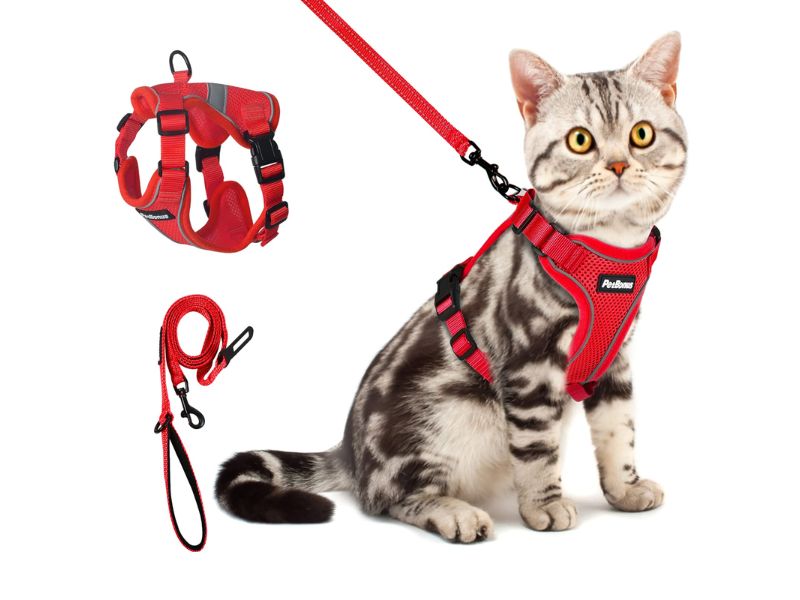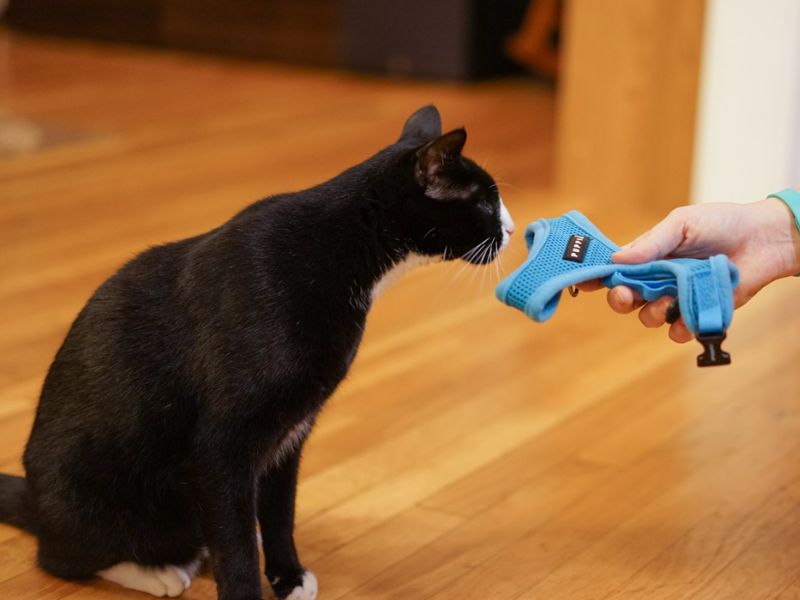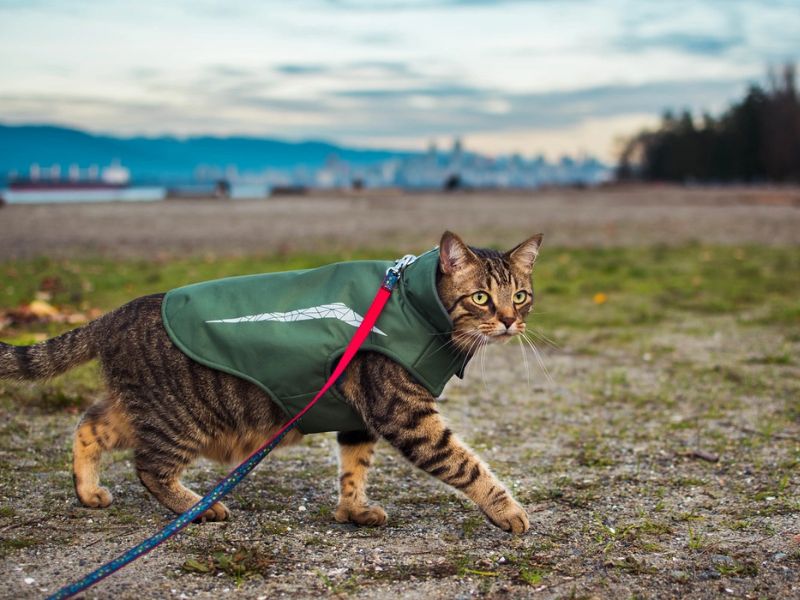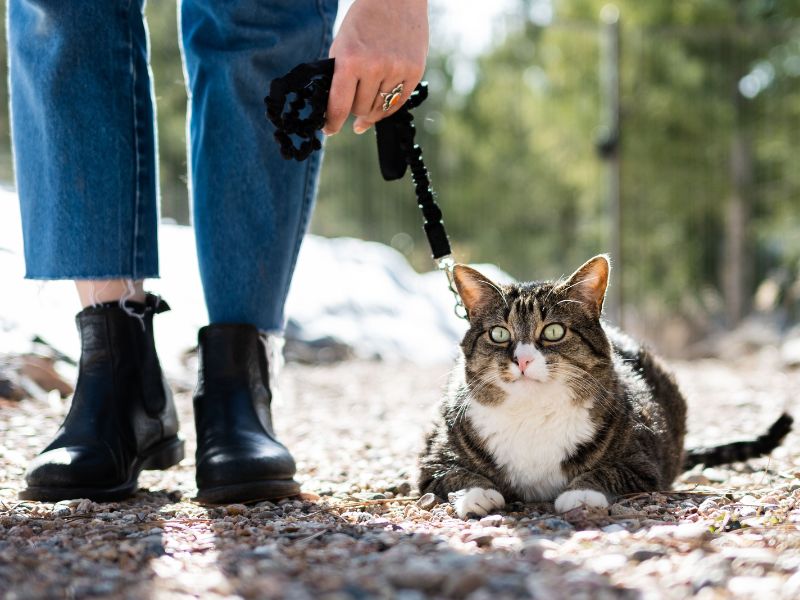You may be curious about how to leash train a cat if you’ve ever considered going for a walk with your feline companion. Cats may often be taught to walk on a leash and enjoy the outdoors, but this is not as frequent as it is with dogs. This article from Canvas Personalized will walk you through the steps of training your cat, from gathering the necessary supplies to acclimating them to the harness.
What You Need Before Leash Training a Kitten?
You’ll need just a few items to begin training the kitten to walk on a leash: a well-fitted harness (or cat-walking jacket) and a shorter leash with some slack. If you’re going to work with cats, you need cat-specific tools. Cats are more independent than dogs. Thus, special equipment is required for cat harness training.

Make sure your cat has been given all the necessary vaccinations and is treated for fleas and ticks. Getting your cat vaccinated against rabies and feline leukemia is crucial since they may come into contact with different animals while exploring the outdoors. It’s important to keep them safe from parasites like fleas and ticks.
If your cat ever gets loose when walking a cat on a lead, microchipping it might be a lifesaver in helping you find each other again.
>>> Do not miss out on this post: How to Train a Cat to Come? – 7 Painless Step-by-step Guide
Step-by-step about How to Leash Train a Cat
Step 1: Get your cat used to wearing the harness indoors

First, fasten the harness around your cat but avoid fastening the leash. Give him a treat or two and take off the harness while he’s still wearing it. Never feed your cat after you’ve taken off their harness; only do it while they’re wearing it. Repeat this step while your cat is on the leash, but gradually increase the length of time spent doing so.
Step 2: Get your cat used to walking on the leash (without tension) indoors

Once your cat is used to wearing the harness, you can interact with the leash. To get started on how to leash train a cat, loosen the leash and follow your cat around while it explores. Take off the harness and leash for a short while. And then, do this step for a few days until your cat feels comfortable walking on the leash.
Step 3: Get your cat used to leash tension indoors
Let your cat move around your house easily while you watch it, and let the leash drag behind it. This will help your cat get used to the feeling of being on a leash. Just remember that you never leave a cat alone with a leash or harness on, and always keep an eye on them.
Step 4: Walk your cat indoors
Get your cat into the harness and on the leash, then continue with How to Leash Train a Cat Step 2. Once your cat has been moving around for a while, you might lead it in a new direction.

If your cat is being stubborn about relocating, try dropping goodies on the floor or holding them between your fingers and rewarding it when it moves.
If your cat starts to walk without your support, be sure to praise him and give him goodies.
Step 5: Go Outside
On a dry, warm day, start by walking your cat to the door and encouraging him to go outside. Help your cat ahead by placing a goodie near the door.
Don’t push your cat outside if he seems scared or uncomfortable. Stop for the day and come back to train the cat to walk on leash another day.

Take some cat snacks with you on your stroll. Keep the time you spend outside to a few pleasant minutes. When training your cat to walk on a leash, it is much better to end on a positive note than on a negative one.
Tips for Walking Cats on a Leash in Public
When you’ve mastered moving around the backyard or sidewalk, you may want to take them for walks in public. Just remember that they’re not a dog, so don’t expect them to act like one. You can count on your cat to take the lead at all times, with you following behind as best you can.
Keep your cat away from busy highways because they may be terrifying for animals, and stay out of dog-populated areas since some canines might try to follow your pet.

Some cats may take to being walked on leashes with great enthusiasm, while others will never get used to it. This is particularly true with senior house cats who are too afraid to go outdoors. To find out how your cat responds, it’s better to take things carefully. Good news if they find it enjoyable! Never force them to do anything if they don’t want to!
>>> Read more: Top 10 Helpful & Crucial Kitten Training Tips For Beginners
Safety Tips for Outdoor Cats
Some cats are happy staying outdoors, but you should be notified of the dangers involved before making that decision. The impact of letting out a cat that has never been outside before might be terrible.
We don’t advise leaving cats outside alone, but if you think yours is educated enough, you should take all the necessary precautions.
Vaccinate your cat at the appropriate ages by visiting your veterinarian. For example, rabies is a significant concern when walking cats on a leash.
Pet owners should spay or neuter their animals. If you let your unfixed cat wander freely, many feral cats will only rise.

The best method to guarantee your cat returns home is to equip it with a breakaway collar, city tags, and identification. Without correct identification, your cat might easily be recognized as a stray, adopted by a new home, or sent to the pound.
Cats who spend a lot of time outside need regular pest care since they are more likely to get infected by common pests, including fleas, ticks, mites, and worms. Using flea and tick medication and taking your cat to the doctor on a regular basis can help keep your pet pest-free.
Outdoor cats should have checkups from the vet often. When cats spend most of their time outside, it might be difficult to discover small signs of injury or sickness, such as urinary problems, skin abrasions, or poor digestion.
Protect them from the weather by providing them with shelter. Your cat will be secure and dry whether it’s hot or cold outside or if it’s merely raining if you have an insulated outdoor cat home.
Should You Let Your Cat Outside?
You may have doubts about your cat’s suitability for outdoor life. This is a question only you can solve. In most cases, allowing cats to have unlimited access to the outdoors is not recommended. There are too many uncontrollable factors. However, some cats survive quite well in the great wild.

Leash training a kitten is preferable if you are unsure or unwilling to take any chances. Once your cat gets used to this new routine, you may go on as many outings as you want, comfortable knowing that your cat will be well monitored.
Walking cats on a leash may add a fun new activity to your daily routine and create a bond between you. Soon, you and your cats may begin to look forward to your daily walks together.
>>> Further reading:
- How to Train a Cat to Use a Litter Box in 3 Effective Steps?
- How to Teach a Cat its Name in 7 Simplest Steps?
You and your cat may have a shared bonding experience using leash training. You can educate your cat and have fun outside by utilizing positive reinforcement methods and being patient and persistent. Leash training should always be done using a harness instead of a collar, and sessions should be kept brief and encouraging.
If you follow these “how to leash train a cat” guidelines and put in the time and effort, you and your cat will soon enjoy leisurely strolls together. Do not forget to check out Canvas Personalized‘s other posts for extra helpful guidance and information.










